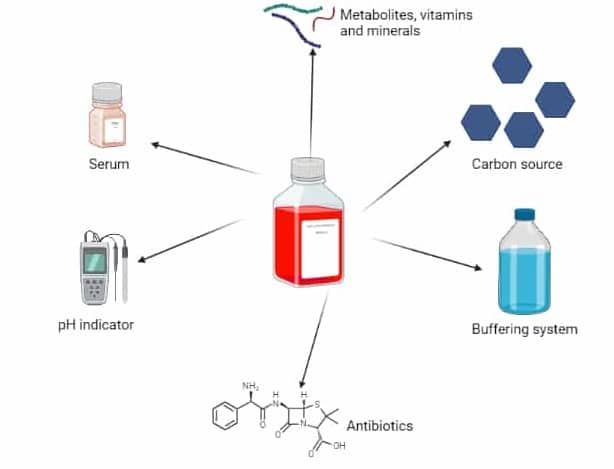
All you need to know about cell culture media
Cell culture is an indispensable tool for the investigation of basic scientific research questions. To grow and maintain cells, cell culture media and supplements critical for their support are very important. Essential cell culture media components include carbohydrates, amino acids, vitamins, minerals, and a buffer system. The choice of cell culture media for the experiments can influence the accuracy, reproducibility, and success of the results. Therefore, it becomes crucial to select the right media and supplements along with creating appropriate conditions (1).
Different types of cell culture media
Cell culture media can be divided into two major categories: natural media and synthetic media. Natural media are derived from tissue extraction or animal body fluids. Serum is the most commonly used natural medium. Other examples include plasma, lymph fluid, bone marrow, and amniotic fluid. In contrast, synthetic media or artificial media are created using a variety of organic and inorganic compounds (2).
Components of cell culture media Cell culture media are a cocktail of many different components designed to support cellular growth. Common components of cell culture media are: Carbohydrates: Glucose is commonly used as an energy source, but other carbohydrates, such as galactose, fructose, or maltose, are also frequently used.
Vitamins: Since vitamins cannot be synthesized in sufficient quantities by cells, they are needed as a supplement in culture media.
Amino acids: Amino acids are the building blocks of proteins and are obligatory ingredients of all known cell culture media. Essential amino acids, in particular L-glutamine, are important to be included in the culture media as cells cannot synthesize these by themselves.
Inorganic salts: Inorganic salts regulate membrane potential and osmolality by providing sodium, potassium, and calcium ions.
Serum: Serum contains hormones, inhibitors, chelators, amino acids, carbohydrates, lipids, vitamins, growth factors, and minerals which are all needed for cellular growth. Bovine serum is the most commonly used.
Hormones: Certain hormones may be added to influence cell function, growth, and proliferation. For example, dexamethasone is added to cell culture media when studying apoptosis, cell signaling pathways, and cell differentiation.
Antibiotics: Antibiotics inhibit fungal and bacterial growth. Buffering systems: Buffering systems regulate the pH of cell culture media.
There are two types of buffering systems, natural and HEPES. In a natural buffering system, controlled gaseous CO2 balances with the CO3/HCO3 content of the culture medium.
HEPES is a biological buffer that maintains the ion concentration and allows for extra buffering capacity. Natural buffers are low-cost, compared to HEPES which is slightly more expensive and even toxic when used at higher concentrations. Basic and trace elements: Cells also need elements like iron, potassium, magnesium, and zinc to grow and proliferate. The addition of trace elements also depends on the research goal (3, 4, 5, 6).
References
1. Segeritz CP, Vallier L. Cell Culture: Growing cells as model systems In Vitro. Basic Science Methods for Clinical Researchers. 2017:151–72. doi: 10.1016/B978-0-12-803077-6.00009-6. Epub 2017 Apr 7. PMCID: PMC7149418.
2. Yao T, Asayama Y. Animal-cell culture media: History, characteristics, and current issues. Reprod Med Biol. 2017 Mar 21;16(2):99-117. doi: 10.1002/rmb2.12024. PMID: 29259457; PMCID: PMC5661806.
3. Vis MAM, Ito K, Hofmann S. Impact of culture medium on cellular interactions in in vitro co-culture systems. Front Bioeng Biotechnol. 2020 Aug 4;8:911. doi: 10.3389/fbioe.2020.00911. PMID: 32850750; PMCID: PMC7417654.
4. Schwartz MA, Both G, Lechene C. Effect of cell spreading on cytoplasmic pH in normal and transformed fibroblasts. Proc Natl Acad Sci U S A. 1989 Jun;86(12):4525-9. doi: 10.1073/pnas.86.12.4525. PMID: 2734302; PMCID: PMC287303.
5. Schnellbaecher A, Binder D, Bellmaine S, Zimmer A. Vitamins in cell culture media: Stability and stabilization strategies. Biotechnol Bioeng. 2019 Jun;116(6):1537-1555. doi: 10.1002/bit.26942. Epub 2019 Feb 21. PMID: 30793282; PMCID: PMC6594077.
6. Salazar A, Keusgen M, von Hagen J. Amino acids in the cultivation of mammalian cells. Amino Acids. 2016 May;48(5):1161-71. doi: 10.1007/s00726-016-2181-8. Epub 2016 Feb 1. PMID: 26832172; PMCID: PMC4833841.



